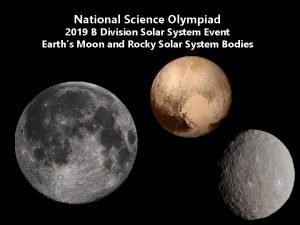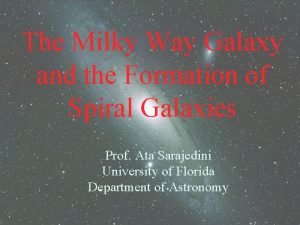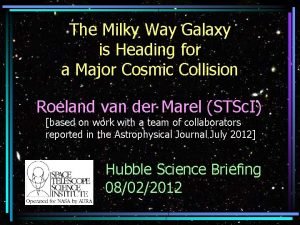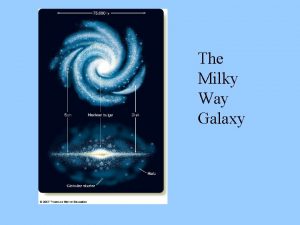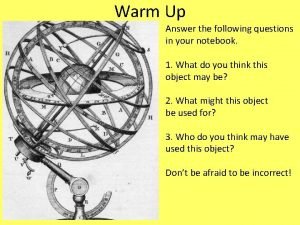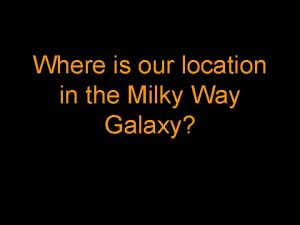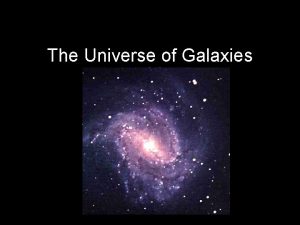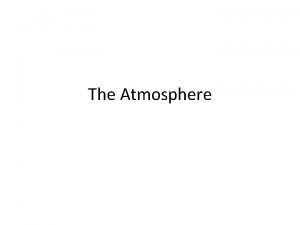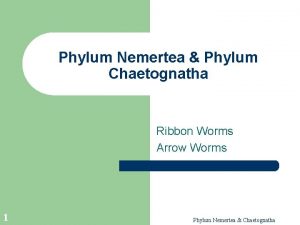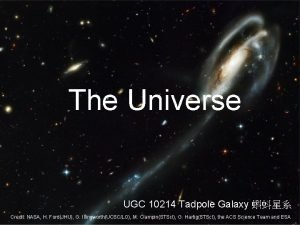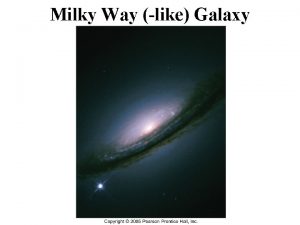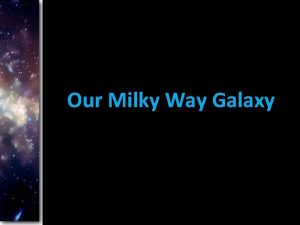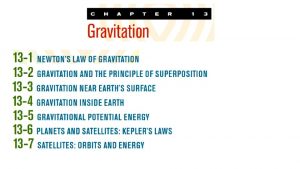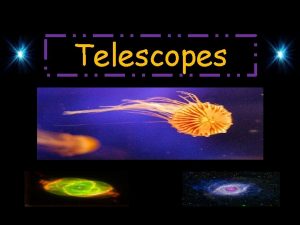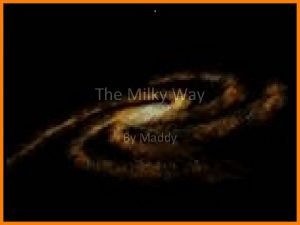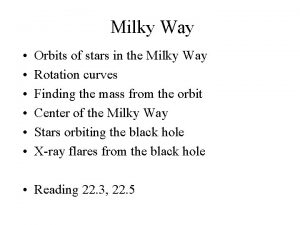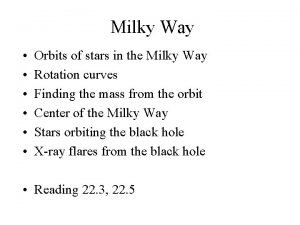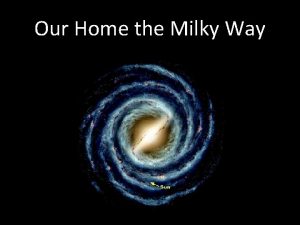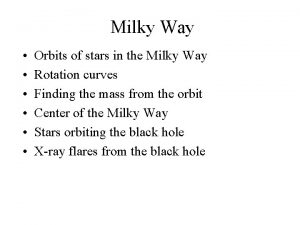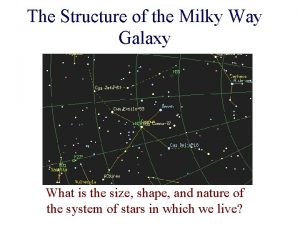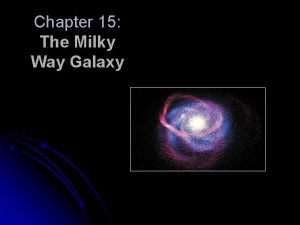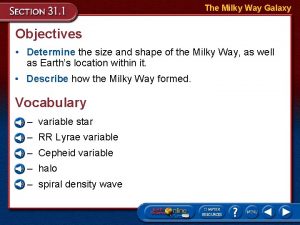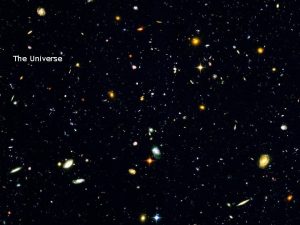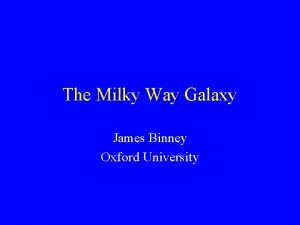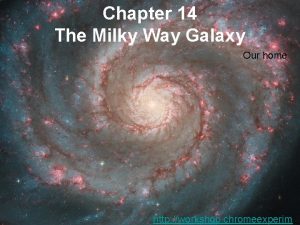The Milky Way Galaxy Structure of the galaxy


























- Slides: 26

The Milky Way Galaxy

Structure of the galaxy • The Milky Way is a spiral galaxy • The galactic center is the thickest part. • Around a dozen arms spin around the center. • The Solar System is on the Orion Arm.

Dimensions of the Milky Way • Distances in the galaxy are measured in kiloparsecs (kpc). • Most of the stars are found near the galactic plane. • Globular clusters are found above and below the plane.

Parts of the Galaxy

What We Actually See From Earth • On Earth, the Milky Way appears to be a white band across the night sky. • In the constellation Sagittarius, we look into the galaxy center and thousands of stars appear.

A Visible View of the Milky Way, pieced together from many pictures.

Photographs using all parts of the spectrum:

How Do We Know the Size of the Galaxy? • Henrietta Leavitt discovered that the period of Cepheid variable stars depends on their absolute magnitudes. • If we know the magnitudes, we can determine distances: D = 10(Mapp - Mabs +5)/5 • You can also read the distance off the graph!

Cepheid Variables are Giants that have left the main sequence. • Polaris is a good example of a Cepheid variable that is found in our region of the galaxy. • Polaris’s magnitude goes up and down 0. 15 in around 3 days on a regular cycle.

Hubble Records a Cepheid

Leavitt Studied Variables in the Small Magellanic Cloud All these stars are around the same distance to us, so those that are bright are really bright.

Dr. Leavitt discovered a variable in the small Magellanic Cloud with an apparent magnitude of +15. 5, and its absolute magnitude is -4. 5. D = 10(Mapp - Mabs +5)/5 D = 10(15. 5 - -4. 5 +5)/5 = 1025/5 = 105 D = 100, 000 pc = 100 kpc

Globular Clusters • Globular Clusters are found on the edges of the galaxy. • Harlow Shapley found the distance to these clusters and he plotted their positions. • For them to fit, the Milky Way must be around 30 kpc across. (Shapley miscalcuated to around 40 kpc.

Modern Globular Cluster Plot • Once the globular clusters are plotted, using correct magnitudes, they form a halo around the galactic plane. • This helps us determine that the center is 8 kpc from the Solar System and that the galaxy is 30 kpc in width. HALO

The Andromeda Galaxy We can’t see the entire Milky Way Galaxy, so we have to use pictures of other spiral galaxies to help us predict its structure. 2 million light yrs. away

The Rotating Galaxy • The long spiral arms of the galaxy tell us that the galaxy is spinning. • It takes around 230 million years for one revolution of the Solar System. • We are not anywhere near the center of the galaxy; we’re just a satellite system.

Radio View of the Milky Way

Evidence of Rotation • The Doppler Shift tells us if an object is moving toward or away from us. • Red shift indicates moving away; blue shift towards us.

The Doppler Shift can be caused by another star’s motion or our motion, or both. We’ve We’re already past catching up them. to them. They’re catching up to us. They’re already past us.

Determining Radial Velocity Vradial = shift x c rest Vradial = 200 x 300, 000 5400 Vradial = 10714 km/sec (Away from us. )

Another Example… The Solar System is overtaking a star on the Perseus Arm, causing a blue shift of 0. 14 nanometers. Vradial = shift x c rest Vradial = 0. 14 nm x 300, 000 700 nm Vradial = 60 km/sec

A problem to try for yourself… An observer near the galactic center sees a red shift for the Solar System of 0. 4 nanometers. The rest wavelength is 600 nm. What is the velocity of the Solar System through the galaxy? Vradial = shift x c rest Vradial = 0. 4 x 300, 000 km/sec 600 Vradial = 200 km/sec Center

Motions within the Milky Way

Population I Stars • The stars of the galaxy are often divided into two populations. • Population I stars are “metal-rich. ” • This means they have elements other than hydrogen and helium • They are found mostly in the galactic plane, and are mostly likely second generation young stars.

Population II Stars • These older stars are found mostly in the halo of the galaxy. They have very eccentric orbits. • They are “metal-poor. ” • They contain almost only hydrogen and helium.

Summarizing Properties of the Milky Way
 Science olympiad solar system
Science olympiad solar system Canis major dwarf galaxy
Canis major dwarf galaxy Milky way galaxy sketch
Milky way galaxy sketch Critical density
Critical density How big is the galaxy
How big is the galaxy Milky way description
Milky way description Where is the solar system located in the milky way
Where is the solar system located in the milky way Democritus milky way
Democritus milky way Dung beetle milky way
Dung beetle milky way Our location in the milky way
Our location in the milky way The milky way
The milky way Milkyway fonterra
Milkyway fonterra Preparation of oxygen
Preparation of oxygen Zjezd
Zjezd Nemertea
Nemertea Milky appearance of plasma
Milky appearance of plasma One way table and two way table
One way table and two way table Two way anova
Two way anova Threaded binary tree
Threaded binary tree Perbedaan one way two way anova
Perbedaan one way two way anova Hypothesis for two way anova
Hypothesis for two way anova One way anova vs two way anova
One way anova vs two way anova Two way anova
Two way anova Conventional software engineering
Conventional software engineering This way that way forwards backwards over the irish sea
This way that way forwards backwards over the irish sea Walk this way talk this way
Walk this way talk this way Ugc 10214
Ugc 10214
